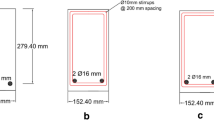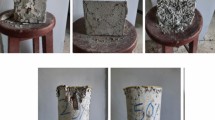Abstract
External vertical prestressing rebars (EVPRs) can effectively improve shear strength of concrete structures by the way of providing vertical compressive stress to the concrete and acting as stirrups. The objective of this study is to obtain a shear strength prediction model of EVPRs strengthening concrete beam without transverse reinforcement enhanced by modifying the ACI-318 and Critical Shear Crack Theory (CSCT). At the same time, this article analyzes the contribution of the strength of the shear strength, including the EVPRs as stirrups, compression zone of concrete, dowelling action, aggregate interlock and residual tensile strength. The results indicate that the shear strength prediction model can fit well with the experimental data and EVPRs can effectively enhance shear strength.
Similar content being viewed by others
Abbreviations
- a (mm):
-
Shear span of the segment without transverse reinforcement
- A s (mm2):
-
Area of longitudinal bars intersects at point A of the critical shear crack
- A sv (mm2):
-
Area of stirrups within spacing sP
- A svP (mm2):
-
Area of the EVPRs within spacing sP
- b (mm):
-
Width of the beam
- b ef (mm):
-
Effective width of concrete in tension
- c (mm):
-
Depth of the compression zone
- c 1 c 2 c 3 :
-
Related parameters in the CSC
- c b (mm):
-
Concrete cover
- d (mm):
-
Effective height of beam cross-section
- d b (mm):
-
Diameter of the longitudinal bar
- d F (mm):
-
Vertical height of the CSC
- d g (mm):
-
Maximum aggregate size
- E c (MPa):
-
Modulus of elasticity of conrete
- E s (MPa):
-
Modulus of elasticity of the longitudinal bar
- E svP (MPa):
-
Modulus of elasticity of the EVPR
- f c (MPa):
-
Concrete compressive strength in cylinder
- f ct,ef (MPa):
-
Effective tensile strength of concrete
- F P (N):
-
Pulling force in the EVPRs
- f t (MPa):
-
Concrete tensile strength in cylinder
- f yv (MPa):
-
Yield strength of stirrups
- f y vp (MPa):
-
Yield strength of the EVPRs
- G F (N/mm):
-
Fracture energy of concrete
- h (mm):
-
Height of beam cross-section
- h F (mm):
-
Vertical distance from the point F of the CSC to the beam top
- k b :
-
Reduction factor tensile strength of concrete
- l (mm):
-
Span length
- l 1 l 2 l 3 l F1 (mm):
-
Integration limits
- l B (mm):
-
Length of segment A-B of the CSC
- l ef (mm):
-
Effective length of concrete in tension
- l F (mm):
-
Length of segment B-F of the CSC
- m:
-
Number of longitudinal bars activated in dowel action
- n P :
-
The arranged number of the EVPRs along the beam width
- r F (mm):
-
Horizontal distance from the point F of the CSC to the loading
- s (mm):
-
The arranged spacing of stirrups along the beam length
- s P (mm):
-
The arranged spacing of the EVPRs along the beam length
- u A (mm):
-
Horizontal opening of the CSC at point A
- v A (mm):
-
Vertical opening of the CSC at point A
- V Agg (N):
-
Shear capacity contribution of aggregate interlock of concrete in the beam without transverse reinforcement
- V c(N):
-
Shear capacity contribution of the concrete in the beam without transverse reinforcement
- V C ompr (N):
-
Shear capacity contribution of compression zone of concrete in the beam without transverse reinforcement
- V comprP (N) :
-
Shear capacity contribution of compression zone of concrete in the beam without transverse reinforcement but enhanced by the EVPRs
- V cP (N):
-
Shear capacity contribution of the concrete in the beam without transverse reinforcement but enhanced by the EVPRs
- V Dowel (N):
-
Shear capacity contribution of dowel action of longitudinal bars in the beam without transverse reinforcement
- V DowelP (N):
-
Shear capacity contribution of dowel action of longitudinal bars in the beam without transverse reinforcement but enhanced by the EVPRs
- V Res (N):
-
Shear capacity contribution of residual tensile strength of concrete in the beam without transverse reinforcement
- V ResAB (N):
-
Shear capacity contribution of residual tensile strength of concrete at the segment A-B of the CSC in the beam without transverse reinforcement
- V ResABP (N):
-
Shear capacity contribution of residual tensile strength of concrete at the segment A-B of the CSC in the beam without transverse reinforcement but enhanced by the EVPRs
- V ResBF (N):
-
Shear capacity contribution of residual tensile strength of concrete at the segment B-F of the CSC in the beam without transverse reinforcement
- V ResBFP (N):
-
Shear capacity contribution of residual tensile strength of concrete at the segment B-F of the CSC in the beam without transverse reinforcement but enhanced by the EVPRs
- V ResP (N):
-
Shear capacity contribution of residual tensile strength of concrete in the beam without transverse reinforcement but enhanced by the EVPRs
- V s (N):
-
Shear capacity of the ordinary stirrups
- V sP (N):
-
Shear capacity contribution of the EVPRs as stirrups
- V u (N):
-
Total shear capacity of the beam without transverse reinforcement
- V uP (N):
-
Total shear capacity of the beam without transverse reinforcement but enhanced by the EVPRs
- w C (º):
-
Maximum opening of concrete allowing to transfer stress in the CSC
- x A (mm):
-
Horizontal distance from the support to point A of the CSC
- x F (mm):
-
Horizontal distance from the support to point F of the CSC
- β AB (º):
-
Angle of the segment A-B of the CSC
- β BF (º):
-
Angle of the segment B-F of the CSC
- ρ :
-
Reinforcement ratio of longitudinal bars
- δ A (mm):
-
Crack sliding of the CSC at point A
- ε s :
-
Strain of the longitudinal bar
- σ zP0 (MPa):
-
Vertical compression stress in the concrete provided by the initial pulling force of the EVPRs
- σ zP1 (MPa):
-
Vertical compression stress in the concrete provided by the EVPRs during the loading process of the beam
- σ zPy (MPa):
-
Vertical compression stress in the concrete provided by the EVPRs when the EVPRs at yielding strength
- ψ (º):
-
Rotating angle of the CSC
- ω A (º):
-
Opening at point A of the CSC
- k c :
-
Coefficient compression zone
- ω B(º):
-
Opening at point B of the CSC
References
Aboutaha R, Burns N (1991) Shear strengthening of pretensioned prestressed concrete composite flexural members. University of Texas at Austin, Austin, TX, USA
Aboutaha RS, Burns NH (1994) Strengthening of prestressed concrete composite beams using external prestressed stirrups. PCI Journal 39(4):64–74, DOI: https://doi.org/10.15554/pcij.07011994.64.74
ACI 318-19 (2019) Building code requirements for structural concrete and commentary. ACI 318-19, American Concrete Institute, Farmington Hills, MI, USA
ACI-DAfStb (2013) Database of shear tests on slender reinforced concrete beams without stirrups. ACI Structural Journal 110(5):867–875
Adhikary BB, Mutsuyoshi H (2006) Shear strengthening of reinforced concrete beams using various techniques. Construction and Building Materials 20(6):366–373, DOI: https://doi.org/10.1016/j.conbuildmat.2005.01.024
Altin S, Tankut T, Anil Ö, Demirel Y (2003) Response of reinforced concrete beams with clamps applied externally: An experimental study. Engineering Structures 25(9):1217–1229, DOI: https://doi.org/10.1016/S0141-0296(03)00082-8
Aurelio M, Joseph S (1991) Behavior of beams and punching in slabs without shear reinforcement. Proceedings of the IABSE Colloquium, Stuttgart, Germany
Aurelio M, Miguel FR (2008) Shear strength of members without transverse reinforcement as function of critical shear crack width. ACI Structural Journal 105(2):163–72, DOI: https://doi.org/10.14359/19731
Bolger P (2006) Strengthening of headstocks with vertical clamping to enhance shear capacity. University of Southern Queensland, Queensland, Australia
Campana S, Anastasi A, Ruiz MFN (2012) Analysis of shear-transfer actions on one-way RC members based on measured cracking pattern and failure kinematics. ACI Structural Journal 65(6):386–404, DOI: https://doi.org/10.1680/macr.12.00142
Chalioris CE, Thermou GE, Pantazopoulou SJ (2014) Behaviour of rehabilitated RC beams with self-compacting concrete jacketing — Analytical model and test results. Construction & Building Materials 55(55):257–273, DOI: https://doi.org/10.1016/j.conbuildmat.2014.01.031
Demir A, Ercan E, Demir DD (2018) Strengthening of reinforced concrete beams using external steel members. Steel and Composite Structures 27(4):453–464, DOI: https://doi.org/10.12989/scs.2018.27.4.453
Dinh HH, Parra-Montesinos GJ, Wight JK (2009) Shear behavior of steel fiber reinforced concrete beams without stirrup reinforcement. The University of Michigan, Ann Arbor, MI, USA, DOI: https://doi.org/10.14359/51663913
Enrique M, Antonio A (1990) Temperature and stress distributions in concrete box girder bridges. Journal of Structural Engineering 116(9):2388–409, DOI: https://doi.org/10.1061/(ASCE)0733-9445(1990)116:9(2388)
Ferreira D, Bairán JM, Marí A (2016) Shear strengthening of reinforced concrete beams by means of vertical prestressed reinforcement. Structure and Infrastructure Engineering 12(3):394–410, DOI: https://doi.org/10.1080/15732479.2015.1019893
Francesco C, Miguel FR, Aurelio M (2015) Shear failures in reinforced concrete members without transverse reinforcement: An analysis of the critical shear crack development on the basis of test results. Engineering Structures 103(15):157–73, DOI: https://doi.org/10.1016/j.engstruct.2015.09.015
Francesco C, Miguel FR, Aurelio M (2017) An analysis of the shear-transfer actions in reinforced concrete members without transverse reinforcement based on refined experimental measurements. Structural Concrete 19(1):49–64, DOI: https://doi.org/10.1002/suco.201700145
Francesco C, Miguel FR, Aurelio M (2018) A mechanical model for failures in shear of members without transverse reinforcement based on development of a critical shear crack. Engineering Structures 157(1): 300–315, DOI: https://doi.org/10.1016/j.engstruct.2017.12.004
Mathieu F, Josee B, Denis M (2019) Shear strengthening of concrete members with unbonded transverse reinforcement. Engineering Structures 180:40–49, DOI: https://doi.org/10.1016/j.engstruct.2018.11.008
Miguel FR, Sylvain P, Muttoni A (2010) Interaction between bond and deviation forces in spalling failures of arch-shaped members without transverse reinforcement. ACI Structural Journal 107(3):346–354
Moon D, Sim J, Oh H (2005) Practical crack control during the construction of precast segmental box girder bridges. Computers & Structures 83(31):2584–2593, DOI: https://doi.org/10.1016/j.compstruc.2005.05.001
Reinhardt HW (1984) Fracture mechanics of an elastic softening material like concrete. Delft University of Technology 29(2):1–42
Rui VR, Olivier B, Aurelio M (2005) Experimental investigation of the shear capacity of plastic hinges. Fib Symposium “Keep Concrete Attractive”, Budapest, Hungary, 651–656
Ruiz MF, Mirzaei Y, Muttoni A (2013) Post-punching behavior of flat slabs. ACI Structural Journal 110(5):801–811
Shamsai M, Sezen H, Khaloo A (2007) Behavior of reinforced concrete beams post-tensioned in the critical shear region. Engineering Structures 29(7):1465–1474, DOI: https://doi.org/10.1016/j.engstruct.2006.07.026
Walraven JC (1981) Fundamental analysis of aggregate interlock. Journal of the Structural Division 107(11):2245–2270
Xue XX, Wang X, Hua XD, Wu MZ, Wu LQ, Ma Z, Zhou JL (2019) Experimental investigation of the shear behavior of a concrete beam without web reinforcements using externally vertical prestressing rebars. Advances in Civil Engineering 2019(2019):1–13, DOI: https://doi.org/10.1155/2019/3452056
Zhang H, Fang Z, Chen B (2018) Experimental study on shear behavior of prestressed reactive powder concrete I-girders. Frontiers of Structural & Civil Engineering 13(7):1–10, DOI: https://doi.org/10.1007/s11709-018-0500-8
Zhao BJ, Yin HJ, Hao XW, Meng J (2011) Analysis on PC box beam webs by vertical prestress in consideration of stress diffusion. Journal of Civil, Architectural & Environmental Engineering 33(6):79–83, DOI: https://doi.org/10.1097/RLU.0b013e3181f49ac7
Acknowledgements
This research was funded by the Scientific Research Project of Educational Department of Liaoning Province (LNZD202005) and the financial support from the project of the MOE Key Lab of Disaster Forecast and Control in Engineering of Jinan University grant number (20200904005). We would like to thank Editage (https://www.editage.cn) for English language editing.
Author information
Authors and Affiliations
Corresponding author
Rights and permissions
About this article
Cite this article
Xue, X., Wu, M., Zhou, P. et al. Theoretical Formula of Ultimate Shear Strength for RC Beams without Transverse Reinforcement by Using External Vertical Prestressing Rebars. KSCE J Civ Eng 25, 2522–2533 (2021). https://doi.org/10.1007/s12205-021-0911-2
Received:
Accepted:
Published:
Issue Date:
DOI: https://doi.org/10.1007/s12205-021-0911-2




